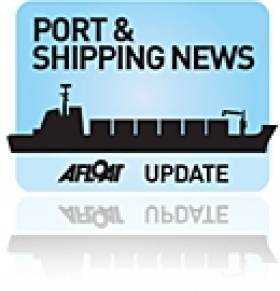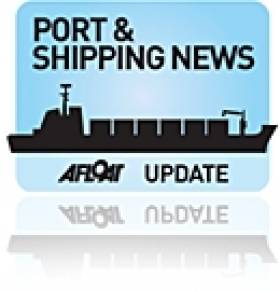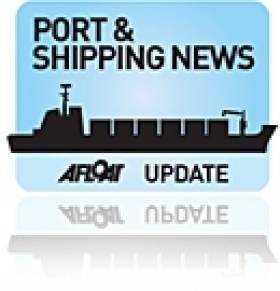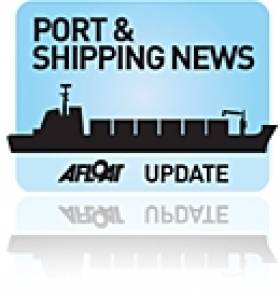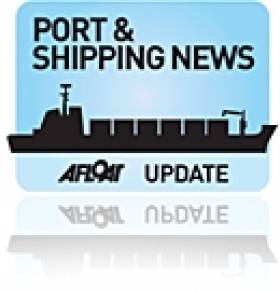Displaying items by tag: Ports & Shipping Review
#ShippingReview – Over the last fortnight, Jehan Ashmore has reported on the shipping scene where among the stories are outlined below.
This year’s theme of World Maritime Day was “Maritime education and training” which was celebrated at the International Maritime Organisation's (IMO) headquarters in London and where other events will be held throughout the year.
d’Amico Tankers Ltd Ireland order construction and sale of two 75,000dwt product tankers with a Korean yard as part of a $755m fleet deal.
Afloat revealed as to the name chosen for Arklow Shipping’s second Royal Bodewes 5,100dwt trader cargoship currently under construction. She will be christened Arklow View and follows the launch of the leadship last month.
Consultants have been appointed by Rosslare Europort to evaluate the market interest of operating the harbour on a consession basis.
It was the place to be as 150 people attended the second Irish Maritime Forum held at the NMCI, Ringaskiddy, where speakers represented organisations and professionals from the broad Maritime Industry in Ireland.
The expansion of Galway Port faces an environmental hurdle, as parts of the plan would have a significant adverse impact on Galway Bay, said An Bord Pleanála in advance of next week's expected decision that already been delayed for many months.
Ports & Shipping Review: Brave Newbuild Launched, Ferry Trials Deep Down Irish Sea, Agreement on CO2 & Sister of Final H&W Built Ship Debuts in Dublin
#Ports&ShippingReview – Over the last fortnight, Jehan Ashmore has reported from the shipping scene, where Arklow Shipping's fifth out of six 'B' class 'green' newbuilds Arklow Brave was launched in the Netherlands.
Another newbuild, German built Loch Seaforth carried out sea trials in the Irish Sea for Scottish ferry operator CalMac, which involved departing the Clyde and heading south as far as the Codling Bank offshore of Wicklow Head.
The Permanent Representatives Committee reached agreement with European Parliament on new EU-wide rules regarding CO2 emissions from ships.
A sister of Anvil Point, the last ship to be built in Belfast by Harland & Wolff in 2003, the Dorset docked in Dublin Port having entered service for Colbelfret's (CLnD Ro-Ro) service from Zeebrugge.
Ports & Shipping Review: ISL 30th Year Reunion, Container Rise 9%, Arklow's Newbuild Brave, CMA-GGM’s $201m Profit
#Ports&ShippingReview: Over the last fortnight, Jehan Ashmore has reported on the shipping scene, where former officers, crew and staff attended a reunion to mark the 30th anniversary of Irish Shipping Ltd, the state company which went into liquidation in 1984.
The Irish Maritime Development Office (IMDO) released figures that showed container shipping volumes, Lo/Lo have risen by 9% in the third quarter of 2014.
Arklow Shipping's fifth out of six B class general cargo 'green' newbuilds, Arklow Brave is to be christened and launched next month at a Dutch shipyard.
French global containership giant, CMA CGM in the third quarter, announced net profit of $201m as cargo volumes reached an all-time high and order for six mega 18,000TEU capacity ships due 2015.
Ports & Shipping Review: EPSO Re-Elect Chairman, Ardmore's Finance Plan, Green Port Award, New Foynes Jetty, Double Ship Incidents and ISL 30th Anniverary
#Ports&ShippingReview: Over the last fortnight, Jehan Ashmore has reported on the shipping scene, where the European Sea Port Organisation (ESPO) re-elected Garcia-Milà as Chairman following a vote of the organisation's General Assembly held in Brussels.
Tanker fleet operator Ardmore Shipping Corporation announced financial results and a $20 million Share Repurchase Plan.
As referred above ESPO, has awarded this year the Slovenian port of Koper in recognition of its environmental work in creating a sustainable future for the port and its surroundings.
The name of the contractor for a €10m plus upgrade of the east jetty at Foynes will be announced shortly by Shannon Foynes Port Company.
Within a fortnight two separate incidents involving a pair of vessels berthed in Warrenpoint, took place at the Co. Down port. The first incident was an oil spill followed by an overheating cargo of animal feed.
A cargoship currently berthed in Dublin Port, Arklow Willow has a similar name to a former Irish Shipping Ltd vessel, the Irish Willow. The timing is apt given yesterday a staff reunion in the capital marked the 30th anniversay of the liquidation of Irish Shipping Ltd.
#Ports&ShippingReview: Over the last fortnight, Jehan Ashmore has reported on the shipping scene, where Warrenpoint Harbour call for funding to construct relief road to avoid traveling through Newry City.
The European Sea Ports Organisation (ESPO) recognised the Italian Presidency efforts at the Transport Council to reach an agreement on Port Regulation proposals.
Shannon Foynes Port Company announced record profits for 2013, the fourth successive year in such growth, showing a 3% increase in Operating Profit at €4.1m, up from €3.1m in 2012.
Government to back Galway Harbour's €52 million redevelopment of a first phase of a port expansion.
The IMDO release report Irish Tonnage Tax: Opportunities for the International Shipping Industry. The independent report by PwC details the benefits of the tax regime established in 2004 and the attractions of maritime operations locating in Ireland.
Dublin Graving Docks Ltd faces closure as Dublin Port Company plan a €200m Alexandra Basin Redevelpment Project that incorporates the site of the 200m long graving dock. Currently the dry-dock is occupied by Arklow Ranger and Jeanie Johnston.
Ports & Shipping Review: Major OPV Conference, Bantry Works 2016, First Irish Maritime Forum, NMCI 10th Anniversary and Samskip On Sulphur
#Ports&ShippingReview - Over the last fortnight, Jehan Ashmore has reported on the shipping scene, where The International Offshore Patrol Vessels Conference was held in Dublin, the three-day event was chaired by Rear Admiral Mark Mellett of the Naval Service.
Councillors at a Western Committee meeting held in Cork, were informed the start date for the redevelopment plans for Bantry Harbour costing up to €7m would not be until at least 2016.
Also in Cork city, more than 150 delegates from the maritime industry attended the inaugural Irish Maritime Forum hosted by the Port of Cork, in partnership with the Irish Ports Association (IPA).
It was then the turn of the IPA's counterpart in the UK, the British Ports Association (BPA) which held their annual conference yesterday which was hosted by Warrenpoint Harbour Authority in Newcastle, Co. Down.
The National Maritime College of Ireland (NMCI) celebrated its tenth anniversary. As a provider of world class maritime education and training, an event to mark the occasion was to be led yesterday by Minister for Marine & Defence, Simon Coveney, TD.
Samskip CEO, Diederick Blom has said the increasing cost of new low-sulphur fuel from the regulations 'may drive a shift back to road transport on certain European shortsea routes'.
Ports & Shipping Review: EU Adopt Custom Plan, Cork of Port Hearing, Ireland-Spain Route Closed, Historic Cruise First for Waterford and much more
#Ports&ShippingReview: Over the last fortnight, Jehan Ashmore has reported on the shipping scene, where the EU adopts a plan to improve customs risk management.
A Port of Cork proposal for a €100m upgrade at Ringaskiddy for a container terminal is to be heard by An Bord Pleanala on 10 September.
Newbuild oil products tanker, Kestral Fisher the second of a pair of 7,072dwt vessels managed by UK based James Fisher Everard docked in Dublin Port.
LD Lines cease operating Ireland-Spain ro-ro ferry services. The 'landbridge' service via France was a historic first to link the nations when launched at the start of this year.
Irish Ferries part of the Irish Continental Group (ICG) release half-year financial report. Since the introduction of ro-pax Epsilon on Welsh and French ferry services, there has been substantial growth from both freight and tourism business.
An historic first for Waterford City Quays, as a record total of three cruiseships bringing more than 900 passengers and 500 crew visited the region.
Manx based Mezeron Freight Services 'classic' coaster cargoship, Silver River (1968/277grt) returned to the Irish Sea following a marine class survey in a Polish shipyard.
Arklow Beacon, the fourth of six 4,800dwt newbuild bulk cargoships, featuring a hull form with 'green' credentials is to be launched at a Dutch yard later this month.
Ports & Shipping Review: Greenore Port for Sale, Irish Port Volumes Rise 2%, Italian Ro-Ro on African Service Reflects International Trade
#Ports&ShippingReview: Over the last fortnight, Jehan Ashmore has reported on the shipping scene, where Dublin Port Company and investment company One51 are to sale Greenore Port.
It further transpired that the strategic port on the shores of Carlingford Lough drew the attention of the Burke Shipping Group, as a bidder in the final stages for the Co Louth port.
The Irish ports and shipping sectors saw a 2% rise in volumes in the Q2 of 2014 when compared to same period in 2013. The latest quarterly results from iShips Index were published by the IMDO.
An example of international shipping trading to Irish ports was the 57,000 tonnes Italian operated ro-ro multi-purpose Grande Atlantico. She anchored in Dublin Bay fresh from an overhaul prior to resuming her Northern Europe-West African 'liner' service.
Ports & Shipping Review: Port of Cork Turnover Up, Cruise Boost for Donegal, Warrenpoint On the Rise and Arklow 'Greens' Dock
#Ports&ShippingReview: Over the last fortnight, Jehan Ashmore has reported from the shipping scene, where the Port of Cork's turnover increased by over 6% in 2013.
The Inishowen Peninsula in Co. Donegal is set to cash in on the lucrative cruise ship sector following investment to upgrade facilities at Greencastle Harbour.
Warrenpoint Port is on its way to economic recovery as a rise in trading activity saw the Co. Down port record a doubling of pre-tax profits to around £850,000 in 2013.
The port on Carlingford Lough welcomed Saga Pearl II, the first ever cruise ship last month and in October the port is to host the 2014 British Ports Association Conference.
Arklow Bank the leadship of six 'B' class 'greener' newbuilds of the Arklow Shipping fleet called to Dublin Port this week. She departed last night laden with a cargo from the Boliden Tara Mines terminal and is bound for Odda, Norway.
Ports & Shipping Review: First Irish Maritime Forum, Galway's Liner Tender Ties, Ireland Sign Maritime Labour Convention
#Ports&ShippingReview: Over the last fortnight, Jehan Ashmore has reported on the shipping scene, where the Port of Cork is to host the first Irish Maritime Forum on 26 September.
The forum themed 'Developing the Dynamic Future for Ireland's Maritime Sector' will focus on exploring the future of the maritime sector within Ireland and will look closely at the challenges and opportunities faced by many within the sector.
Having made an anchorage call off Galway Harbour, Holland America Line's 800 passenger Prinsendam and her fleet of tenders leave in their wake strong ties with the mid-west port.
Minister for Transport, Tourism and Sport,Paschal Donohoe TD, and the Minister for Jobs, Enterprise and Innovation, Richard Bruton TD, announced the ratification by Ireland of the Maritime Labour Convention, which sets standards for working and living conditions for seafarers.
Dublin Port Company's 2013 Annual Report is now available as an 'online' version. The report in both Irish and English is downloadable in PDF format as well as an HTML version are now available through this LINK.



























